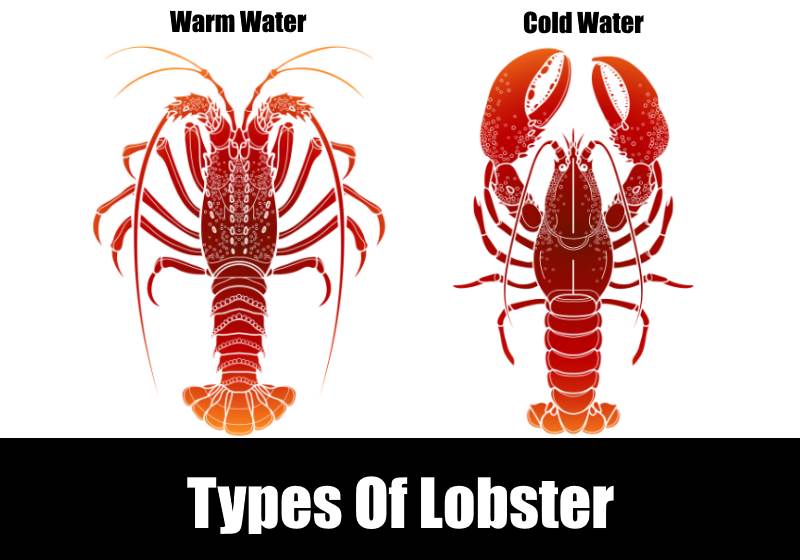Lobsters are Decapods of the Crustacean line. They have five sets of legs. Over time, some lobsters have developed front claws.
Generally, any lobster with defined front claws is a cold water lobster, and any lobster with five sets of appendages but no front claws is a warm water lobster.

Characteristics Common To All Lobsters
Per the Marine Education Society of Australasia, lobsters are omnivores that feed at night. They eat some plants, fish, and other crustaceans.
When necessary, they will scavenge from dead carcasses. In addition to humans, lobsters are food for fish, crabs and seals.
All lobsters molt or shed their shell to grow, so all lobster varieties have hard and soft shell seasons.
Once they’ve molted and are growing a new carapace, they puff up their own flesh with water to stretch the soft carapace and create a roomier shell. This water-loaded flesh provides a different flavor.
Soft lobsters are more fragile and thus harder to ship.
The handling difference between soft and hard shells alters the amount of work necessary to cook a lobster and put on your plate.
- When choosing between cold water lobster vs warm water lobster, price is a good guide.
- Depending on the molting stage, lobster may be abundant on the coasts and scant inland.
- If claw meat is your favorite, you’ll need a cold water lobster.
When you open the menu and see “Market Price” listed for lobster, be aware that the lobster farmer is facing a lot of variables.
Warm Water Lobster

The traditional image of a lobster is one with large front claws. However, the front set of legs on warm water lobsters are not claws but rather like antennae.
If you see a photo of a lobster without claws, it’s a warm water lobster. It may also be called a rock lobster or a spiny lobster.
Pacific Lobster
Pacific lobster is a rock or spiny lobster that has no defined front claws. When harvested, they are usually between one and five pounds, though they can grow to fifteen pounds.
They are excellent sources of lobster tail and are generally less expensive than cold water lobster.
Per PacSeaFood.com, the largest harvests of these lobsters are caught during the winter months.
Caribbean lobsters
Caribbean lobsters are found along the shore of the Caribbean, throughout the Gulf of Mexico, and along the North American coast.
Per Marinebio.org, Caribbean lobsters spawn from April through October, when the water reaches 73 degrees Fahrenheit / 23 degrees Celsius.
Caribbean Lobster Tails

These lobsters are commercially fished, primarily for their tails. Currently the minimum size Caribbean lobster that can be caught and processed by commercial fishermen is 3 inches / 7.6 centimeters.
Their shell is harder than a cold water lobster and patterned in gray and brown stripes with yellow spots on the tail.
South African lobster
South African lobster is another warm water lobster featuring long appendages instead of claws that serve as antenna.
Lobsters move slowly when going forward, but when startled can back up quickly thanks to their wide tails.
While South African lobsters are, as a species, not cold water lobsters, they live in cold water. They grow more slowly than Caribbean lobster and have a unique flavor due to the muscular quality of their tail.
Australian lobster
Australian lobsters are available in both red and green.
While most lobsters run from shades of red to brown, often with spotted tails, the Jasus Verrauxi is a unique lobster harvested off the northwest coast of Australia.
In addition to their beautiful green shell, this lobster is renowned for offering a smooth, delicate flavor. Each of these succulent tails weighs in at eight to ten ounces.
Cold Water Lobster
Canadian lobster
Canadian lobster is harvested from the Atlantic on the east coast of Canada. Depending on when it’s harvested, you’ll get a hard shell or a soft shell.
Canadian lobster harvesting season is staggered to protect the lobster population during their summer molts.
Per TasteLobster.ca, this harvesting tradition reduces extreme dips in lobster population.
Maine lobsters
Maine lobsters are the same species as Canadian lobster, otherwise known as Homarus americanus. If you’re a fan of claw meat, Maine and Canadian lobsters will definitely be your favorites.
Hungry for Maine lobster? Check out our latest guide, Buying Lobster Online.
Per the Gulf of Maine Research Institute the closest thing in the world to Maine lobster is the Homarus gammarus, or European lobster. This lobster has an even bigger claw than the Maine lobster.
Lobster is available on nearly every sea coast. The primary factors that impact flavor quality are:
- Freshness. If warm water lobster tails, flash frozen and shipped to your grocery store, are thawed properly and eaten quickly, they should have good flavor.
- Age. The older the lobster, the tougher the meat. If you’re shopping and have the chance to buy several one pound lobsters or a few large ones, get the little ones.
- Buying in season. Lobsters are easier to transport when their shell is hard. You’ll get a better selection and better quality if you educate yourself about molting season in your area. Like other seasonal foods, the selection is finest when the food is abundant.
Don’t be afraid to try lobster! Buy small flash frozen tails, thaw them carefully and cook immediately. When you build your skillset, you can move on to fresh lobsters.











